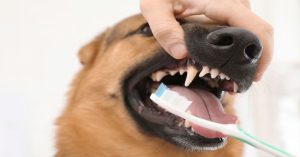Dogs show their teeth as a sign of aggression, fear, or discomfort. Understanding the context and body language is critical to deciphering the underlying cause of this behavior.
When a dog displays its teeth, it may be signaling that it feels threatened or is trying to establish dominance. If the behavior is persistent, seeking guidance from a professional dog behaviorist is advised to address the root cause and prevent potential conflicts or harm.
Identifying the triggers and addressing any underlying issues through proper training and socialization can help modify this behavior and ensure a harmonious relationship with your furry companion. It’s essential to approach the situation with caution and empathy to create a trusting environment for both you and your dog.
Dog Teeth Display: Behavior Insight
Dogs communicate using an array of body language cues, with one of the most noticeable being the display of their teeth. Understanding why dogs show their teeth and the different messages they can convey is essential for dog owners to interpret their pet’s behavior accurately. This article delves into the underlying reasons for dog teeth display and how to differentiate between aggressive and submissive displays.
Understanding Why Dogs Show Their Teeth
When a dog shows its teeth, it’s their way of conveying feelings and intentions. This behavior originates from ancestral instincts and serves as a form of communication. Dogs may show their teeth to express emotions such as fear, submission, aggression, or insecurity. It’s crucial to observe the context and other accompanying body language to interpret what the dog is trying to communicate.
Differentiating Aggressive Vs. Submissive Display
It’s imperative to differentiate between aggressive and submissive displays when a dog bares its teeth. An aggressive display typically involves a stiff body posture, direct eye contact, and a raised tail, indicating a dog that feels threatened or confrontational. On the other hand, a submissive display may include a lowered head, averted gaze, and a relaxed body posture, suggesting the dog is trying to convey a non-threatening, appeasing message.
Signs Of Canine Communication
Teeth Showing As A Form Of Expression
When dogs show their teeth, it can be misunderstood as a sign of aggression. However, it is essential to recognize that bared teeth can convey a range of emotions and intentions, not solely aggressive behavior. Dogs may bare their teeth as a defensive gesture, showing discomfort or fear, or as a playful expression. Understanding the context and accompanying body language is crucial in interpreting this form of canine communication.
Recognizing Other Body Language Cues
Aside from bared teeth, dogs communicate through a variety of body language cues. These include ear positioning, tail wagging, eye contact, and overall posture, all of which provide valuable insights into a dog’s emotional state and intentions. Combining these cues with teeth showing enables pet owners to better understand their furry friends and anticipate their needs.
When Smiles Aren’t Friendly
The Growl Behind The Grin
When a dog bears its teeth, it does not always mean the dog is happy or content. In many cases, teeth-baring is accompanied by a low growl or snarl. This can be a clear indication that the dog is feeling threatened or aggressive. Dogs may bear their teeth as a warning to stay away when they feel uncomfortable or scared.Teeth Baring In Dog-to-dog Interactions
When dogs bare their teeth at each other, they may be engaging in a display of dominance or aggression. This behavior typically arises in territorial disputes or when dogs establish a pecking order within a group. Dog owners need to intervene and separate the animals to prevent potential conflicts or fights.Analyzing Teeth Exhibitions
When we observe our furry friends showing their teeth, it can lead to confusion and concern for many dog owners. It’s essential to decipher the contexts in which dogs commonly exhibit this behavior and to understand how it relates to their emotional state. Let’s delve into the intriguing topic of analyzing teeth exhibitions in dogs.
Contexts Where Dogs Commonly Show Teeth
Dogs exhibit teeth flashing or lip curling in various contexts. Here are some common situations where this behavior may occur:
- During play or roughhousing
- When feeling threatened or defensive
- In response to pain or discomfort
- As a part of their communication with other dogs or humans
Relating Behaviors To The Canine Emotional State
Understanding the emotional state of a dog when displaying their teeth is crucial for discerning their intentions. Certain behaviors might indicate specific emotional states:
- Aggression or fear when showing teeth with raised hackles
- Relaxed playfulness with a loose, wagging tail and a relaxed body posture
- Anxious or stressed behavior with tense body language and dilated pupils
Canine Behavior Explained
Canine behavior is a fascinating topic that delves into the intricate dynamics of our furry companions. One common behavior that often puzzles pet owners is the act of dogs showing their teeth. Understanding the reasons behind this behavior can provide insightful clues into the intricacies of canine communication and social dynamics.
The Reason Behind Teeth Showing In Canines
When a dog shows its teeth, it can be a sign of various emotions and intentions. Aggression, fear, playfulness, and even a submission gesture can all be expressed through this action. It’s essential to consider the context and accompanying body language to interpret the underlying message accurately.
Comparing To Wild Ancestors And Pack Mentality
To comprehend why dogs display such behaviors, it is beneficial to look back at their ancestors and understand their pack mentality. In the wild, wolves and other canids often use teeth display as a part of their communication, signaling dominance or submission within the pack. Even though dogs have been domesticated, these primal instincts still influence their behaviors, especially in social interactions with other dogs and humans.
Grinning For Peace
Submissive Smiling In Canines
Dogs often employ a behavior known as “submissive smiling” to communicate their peaceful intentions. This action involves exposing their teeth in a relaxed manner, rather than as a threat. It is an appeasement gesture that can signal to other dogs or humans that they come in peace and wish to avoid conflict.
When Dogs Use A Teeth Show For Appeasement
When dogs use a teeth show for appeasement, they are expressing a willingness to submit to the authority or presence of another individual, canine or human, peacefully. This behavior can be a valuable tool for social harmony in dog communities and can also serve as a way for dogs to navigate their relationships with humans.
Decoding Aggressive Gestures
Understanding your dog’s behavior can be challenging, especially when it comes to deciphering aggressive gestures, such as showing their teeth. While it’s essential to recognize when your dog is feeling threatened or uncomfortable, it’s also crucial to distinguish between playful behavior and potential danger.
Identifying Signs Of Potential Danger
Dogs communicate through a combination of body language and vocalizations, and understanding these signals is key to interpreting their emotions. When a dog shows its teeth, it’s essential to look for accompanying signs, such as raised fur, stiff posture, and a low growl. These are potential indicators that your dog is feeling threatened and may resort to aggressive behavior if the situation escalates.
When Teeth Showing Is A Warning Sign
When a dog bares its teeth, it’s a clear warning sign that they are feeling threatened or stressed. This gesture is often accompanied by a tense body posture and intense eye contact, indicating that the dog is ready to defend itself if necessary. It’s important not to dismiss this behavior and to address the underlying cause to prevent potential aggression.
Training Away From Tooth Displays
When your dog exhibits tooth displays, it’s crucial to address this behavior through appropriate training techniques. Proactive training can help your dog feel more comfortable and secure in various situations, ultimately reducing the likelihood of tooth displays. By using positive reinforcement techniques and seeking support from a behaviorist when necessary, you can effectively train your dog away from showing his teeth.
Positive Reinforcement Techniques
Utilizing positive reinforcement techniques is an effective way to discourage tooth displays in your dog. By rewarding desired behaviors with treats, praise, and affection, you can positively reinforce good conduct and encourage your dog to replace negative behaviors with positive ones. Consistency and patience are key when employing positive reinforcement, as gradual progress can lead to lasting behavioral changes.
Working With A Behaviorist For Severe Cases
If your dog’s tooth displays are severe or if you have difficulty managing the behavior on your own, seeking assistance from a professional behaviorist is highly recommended. A behaviorist can provide tailored strategies and interventions to address the underlying causes of the behavior while also guiding you through the training process. Their expertise and experience can offer valuable insights into your dog’s behavior and help devise a comprehensive plan for overcoming tooth displays.
Your Dog’s Dental Language
Dogs communicate using a combination of body language, vocalizations, and facial expressions, including the display of their teeth. Understanding your dog’s dental language is crucial for deciphering their feelings and maintaining a healthy relationship with them. In this article, we will delve into why dogs show their teeth and demystify the message behind this behavior.
How Your Reaction Affects Their Behavior
When your dog shows their teeth, your response can greatly impact their behavior. Reacting with fear or aggression may exacerbate the situation, potentially leading to increased anxiety or defensive behavior from your dog. Furthermore, displaying nervousness or retreating may reinforce the belief that they need to protect themselves, exacerbating the issue. Conversely, responding with calmness and asserting yourself as the leader can alleviate the tension and communicate to your dog that there is no need for aggression.
Establishing Trust Without Reinforcing Fear
It is crucial to establish trust with your dog without reinforcing fear. By recognizing the various signals your dog exhibits and responding appropriately, you can build a strong foundation of trust. Avoid punishing or scolding your dog for showing their teeth, as this may exacerbate the feelings of fear or defensive aggression. Instead, focus on redirecting their behavior and rewarding positive interactions, reinforcing the message that showing teeth is unnecessary for communication.
Frequently Asked Questions
Why Does My Dog Bare His Teeth When Playing?
Baring teeth is a natural canine communication signal, often part of playful behavior or excitement.
What Does It Mean When My Dog Shows His Teeth?
Your dog might be expressing a range of emotions, from playfulness to fear or aggression.
Is It Safe To Pet A Dog That Shows His Teeth?
Approach cautiously and read your dog’s body language. Seek professional guidance if needed.
How Can I Train My Dog Not To Bare His Teeth?
Positive reinforcement training can help modify this behavior. Seek a professional dog trainer’s help.
When Should I Be Concerned About My Dog Showing His Teeth?
If it occurs during interactions with people or other animals, consult a veterinarian or dog behaviorist.
Can Medical Issues Cause My Dog To Bare His Teeth?
Yes, pain or discomfort, such as dental problems, can lead to apparent aggression. Consult a veterinarian.
Conclusion
Understanding why your dog shows his teeth is vital for a harmonious relationship. By delving into the possible reasons and seeking professional help if needed, you can ensure your dog’s well-being. Remember, patience and empathy are the keys to nurturing a trusting bond between you and your furry companion.
Related posts:
 My Dog Has Never Had His Teeth Cleaned: The Shocking Consequences of Neglect
My Dog Has Never Had His Teeth Cleaned: The Shocking Consequences of Neglect
 Can Dogs Regrow Teeth ? The Ultimate Guide
Can Dogs Regrow Teeth ? The Ultimate Guide
 Can You Floss Dog’S Teeth ? Expert Tips for Pet Dental Care
Can You Floss Dog’S Teeth ? Expert Tips for Pet Dental Care
 When Do Golden Retrievers Lose Their Baby Teeth?A Guide for Pet Owners
When Do Golden Retrievers Lose Their Baby Teeth?A Guide for Pet Owners
 When Do Golden Retrievers Stop Teething? Answers and Tips
When Do Golden Retrievers Stop Teething? Answers and Tips
 How Strong are Dogs Teeth?
How Strong are Dogs Teeth?


1 thought on “Why Does My Dog Show His Teeth?”
Ive read several just right stuff here Certainly price bookmarking for revisiting I wonder how a lot effort you place to create this kind of great informative website